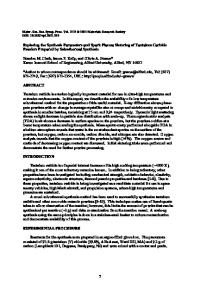Recent Advances on Bulk Tantalum Carbide Produced by Solvothermal Synthesis and Spark Plasma Sintering
- PDF / 663,940 Bytes
- 12 Pages / 432 x 648 pts Page_size
- 21 Downloads / 280 Views
Recent Advances on Bulk Tantalum Carbide Produced by Solvothermal Synthesis and Spark Plasma Sintering Braeden M. Clark,1 James P. Kelly,1 and Olivia A. Graeve1,* Kazuo Inamori School of Engineering, Alfred University Alfred, NY 14802, U.S.A. ABSTRACT The sintering of tantalum carbide nanopowders by spark plasma sintering (SPS) is investigated. The washing procedure for the powders is modified from previous work to eliminate excess lithium in the powders that is left over from the synthesis process. The sintering behavior of the nanopowders is investigated by X-ray diffraction and scanning electron microscopy by studying specimens that were sintered to different temperatures. To improve the homogeneity of the microstructure of the specimens, milling procedures were implemented. Vaporization during sintering is observed, and the usefulness of carbon additions and systematic decreases in temperature to curb this behavior was explored. Future experiments to achieve full density and to maintain a nanostructure of the specimens include sintering with higher pressures, lower temperatures, and longer dwell times. Additives for maintaining a nanostructure and developing suitable high-temperature properties are also discussed. INTRODUCTION The following work describes the process of sintering tantalum carbide in an attempt to obtain dense and nanostructured specimens. Tantalum carbide is one of the most refractory ceramics known with a melting temperature of around 3800°C. Therefore, this material is potentially useful for space reentry vehicles and high mach aircrafts, where extreme temperatures are reached. Other properties, including hardness, fracture toughness, elastic moduli, oxidation behavior, electronic structure, and optical properties, have also been investigated for this material.1-4 The preparation of bulk nanoceramics can result in improved material properties. Maintaining a nanostructure has been shown to modify electrical properties and mechanical properties, for instance.5-7 Properties that did not exist in a material with grain sizes in the micrometer range can potentially exist when the grain size is reduced to the nanometer scale.8 Spark plasma sintering is a useful technique to consolidate powder because of the simultaneous pressure and current applied to create fast heating rates and sintering cycles, which can substantially limit the amount of grain growth of a sintered specimen. This technique is investigated for sintering tantalum carbide nanopowders synthesized by a solvothermal synthesis method. EXPERIMENTAL PROCEDURE Previous sintering work revealed that the scaled-up synthesis of tantalum carbide powders, which were subsequently sintered, still contained lithium left over from the synthesis *
Author to whom correspondence should be addressed: Email: [email protected], Tel: (607) 871-2749, Fax: (607) 871-2354, URL: http://people.alfred.edu/~graeve/
9
process.9 Tantalum carbide powders were synthesized using a solvothermal technique previously established to produce a 50 g theoretical yield of
Data Loading...











